There’s not much sewing happening around these parts at the moment, I’m using my break to catch up on house and garden stuff, and electronic chores, which includes catching up on blog posts! I’m considering making a side blog for house/garden stuff, but the thought of having TWO places to neglect is a little overwhelming. Does anyone have any preferences? I’m not sure who exactly my audience is these days. Perhaps I’ll just continue to use this as a general dumping ground for whatever I feel like putting out into the word on any given day, and leave it up to the reader to opt out of any posts that don’t interest them.
My last post talked about building the wicking beds. Here’s what they looked like in early April, when the sheep manure had rotted in enough to enable planting out.

The bird nets went on because as soon as I planted things, the backyard was immediately overrun with pigeons. I initially just laid the netting over the top while I got the materials to build hoops, and I looked out the window one morning to see a pigeon very carefully treading it down so it could reach the seedlings. Argh! After the autumn I found I didn’t have much trouble with birds, so the nets came off. I think it was probably a bit of a food gap for them.
I’d expended all my gardening energy on the beds rather than on starting seeds, so I planted mostly seedlings I bought from the local farmer’s market in the front bed (the one closest to the house, the left bed in the above photo). I had managed to start a few brassica seedlings though, and I planted them out probably a bit early because I couldn’t wait to get started! They went in the back bed (on the right in this photo) and the side bed (at the back of the photo) had broadbean, sugar snap and snowpea seeds direct sewn into it.
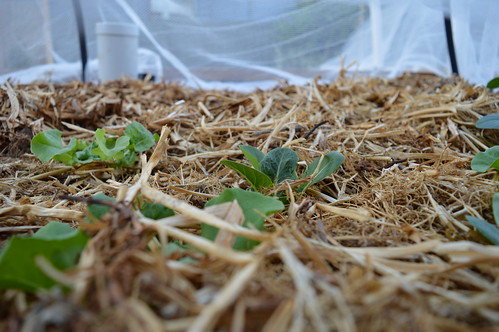
Here’s the front bed, with my boughten bok choy and lettuce seedlings. I also direct sewed into this bed – carrots and beetroot and parsnip up the back, and various greens at the front. The pvc tube you see sticking out at the back is an in-bed worm farm. The idea being you put worms in the bed and then feed them through the pipe with the lid on, so that nothing else can get to the food scraps. I haven’t used it much because they were sluggish over winter and as it got warmer there were plenty of plant roots sans their tops, that needed chewing up. I have periodically checked on them and topped them up a little, though.
I was biting off a bit more than I was sure I could chew, at this point. I had initially intended to start with one or two beds and work my way up, but since it made so much economic sense to buy all the beds at once, that’s what I did. I planted them all out because… well because I got excited. But also because, being wicking beds, the maintenance was fairly easy going. In winter I found I could leave them for weeks at a time with no great consequences. And it’s much better to have things growing in terms of soil health and weed cover, as well as to keep the water wicking and prevent it getting stagnant in the reservoirs.
The other factor was the almost total absence of any kind of insect life in the backyard. There were relatively few plants there when we arrived, but I also suspect the previous owners sprayed the crap out of the place. There are just almost no bugs. That meant not much pollination and it also meant that the first bugs to arrive were pests, with no predators. Planting things that may end up going to seed was pretty much a good thing at this point. I’m happy to report that although there’s still not a huge amount of insect life, a year in there are plenty of bees (at least when there are flowers for them), and many fewer mosquitos. There’s also plenty of species of birds and even bats.
Anywho. Here’s the back bed in June

Chock full of brassicas. There was cauliflower, kale, two kinds of sprouting broccilli (purple and green), two kinds of cabbage (purple and green).
And the front bed
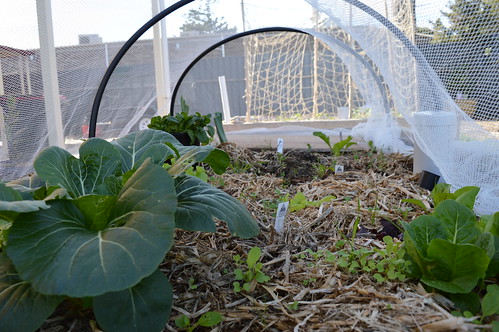
Bok choy on the left, lettuce on the right. Baby spinach in a pot set into the soil up the back, scattered seeds of mixed asian greens coming up everwhere.
And broad beans in the side bed
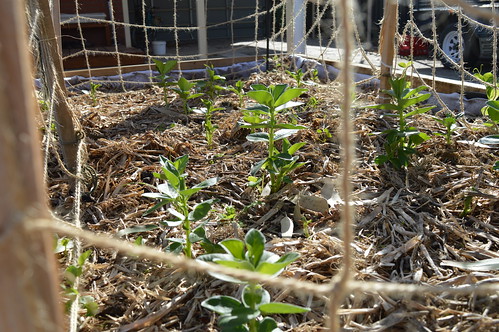
You can just see the snow peas just coming up on the perimeter of the trellis. This bed did not do very well, though (spoiler alert?). The peas took a long time to establish and then, I think, got rust. The bed was quite damp, I think because of the drainage issue I mentioned in my last post where we didn’t angle the outlet down. Also I think not having established plants meant it stayed quite damp – in future I will always try to have at least some lettuce seedlings or something to make sure the water is circulating. Especially in this bed – the other two get a lot of evaporation because they are oriented so the wind blows all the way down them, whereas this one is side on to the wind and so although it still is a factor, it’s much less extreme.
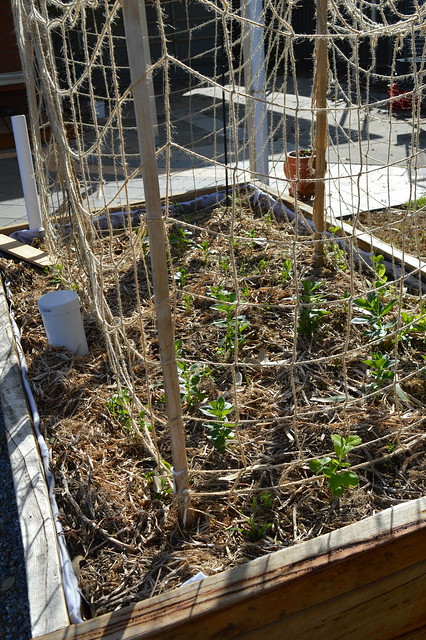
Also the jute trellis was not secure enough, especially with the high winds we get. I eventually added in wire mesh and that helped but I think a lot of the damage was done by that point. I got a meagre crop from this bed but that’s ok, I was essentially considering it a cover crop. And it did make for one very delicious risotto. I think next year I wouldn’t bother planting pea seeds until May, since that’s when they started to actually grow.
Also in May we bought and planted a Reed avocado.
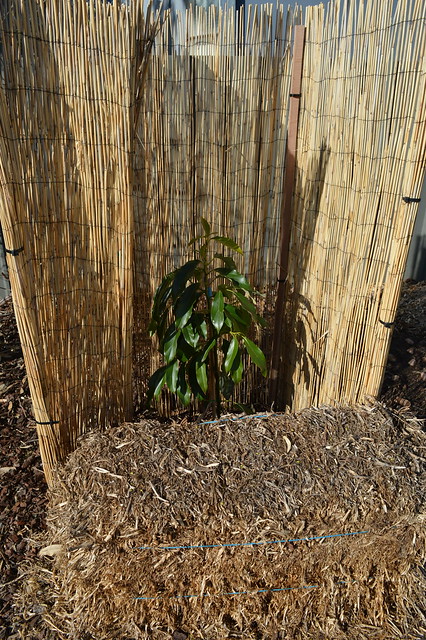
That’s the shade structure we gave it – more spoiler alerts, it was totally inadequate, especially since it (along with most of the garden) gets the very strong afternoon sun + salt in the wind. The strawbale is for warmth and seems to have worked quite well for that.
At the same time we bought a Eureka lemon, seedless Valencia orange and Imperial mandarin, which we planted down by the east facing fence and which I neglected to take a photo of in May, so you’ll have to imagine it. The idea is to semi-hedge them so they stay smallish, since the fruit grows on the outside branches anyway. That way they’ll be manageable and I can keep them below fence height to keep them protected from our strong winds.
This is what the poor Avocado looked like in July

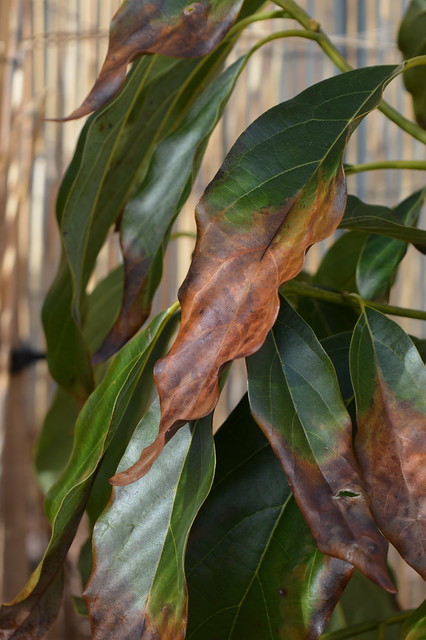
But on the plus side it didn’t seem to get wet feet in spite of reasonably heavy rain – we had a dry winter and spring overall but with several weeks that were very very damp.
Here are the July peas, still showing promise
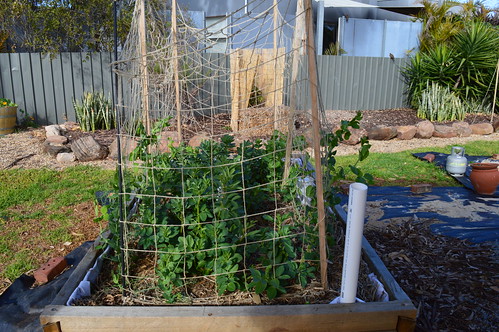
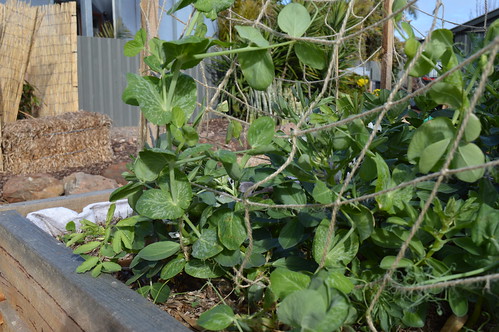
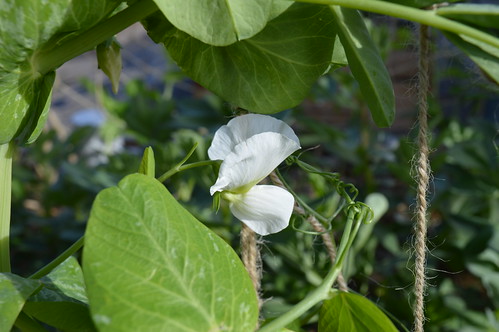
These minature fruit trees in wine barrels were left by the previous owners. They had a big dog and these pots were wrapped in hardware cloth so I suspect it was their way of having any garden at all. However, it was essentially impossible to keep them wet enough, even in winter. They just get too much sun, the whole backyard is not a good spot for pots except for in the shelter of the verandah, and the wine barrels are to heavy and too falling apart to move.
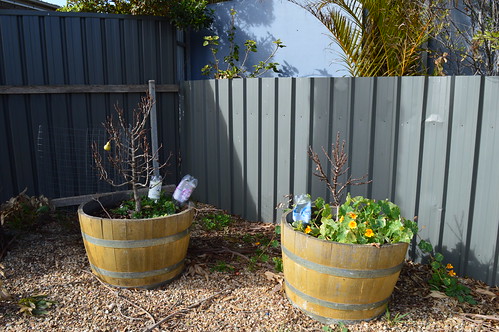
I got this one pear and a couple of tiny but delicious peaches. They also did a glorious show of mini autumn red leaves. I planted the nasturtiums in an effort to mulch them. This summer I’ve just left them with no water and I think they are all but dead. It’s a shame but I’ve nowhere in the ground to put them right now, and the pots are just not a practical thing in this garden, right now.
Here’s the back bed of brassicas in July, showing promise
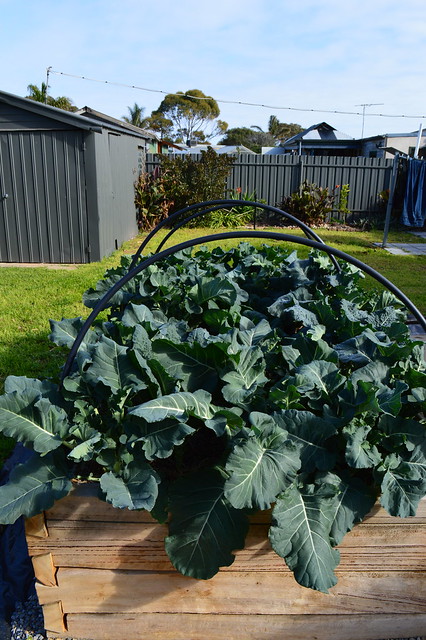

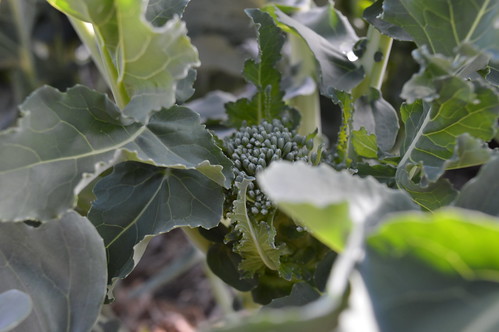

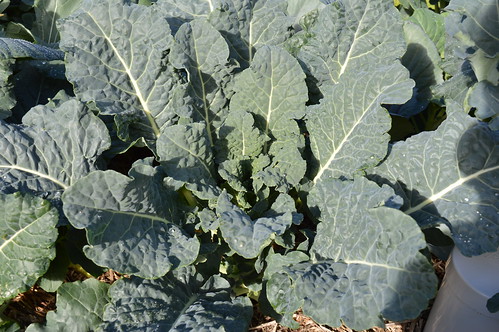
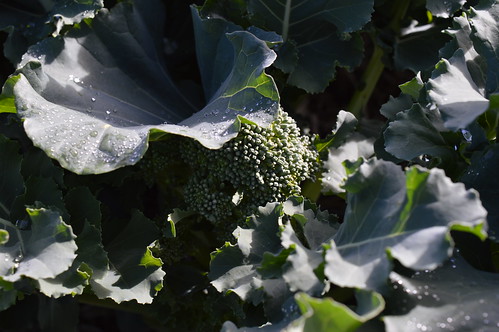
But the true star of July was the front bed, with the mixed greens – you can see the bok choy is a bit nibbled by I’m not sure what. The humans still ate it, though. There was enough to share.

This bed produced, and produced, and produced. The lushest, easiest lettuces and the most succulent bok and pak choy. It just kept on going, growing more greens than even we could eat!
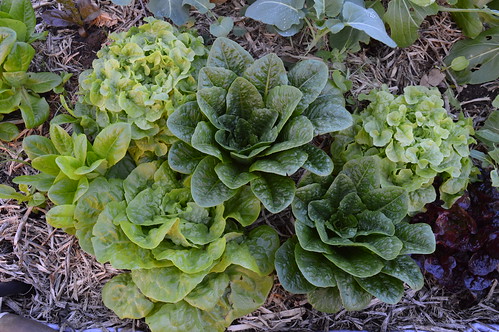
I am absolutely using this bed in the same way next year, it had the perfect aspect for delicate winter greens. What a luxury to always be able to pick a variety of lettuce for an impromptu salad!

There’s the beetroot and parsnips in a row, with silverbeet behind.
More silverbeet, possibly my favourite vegetable:
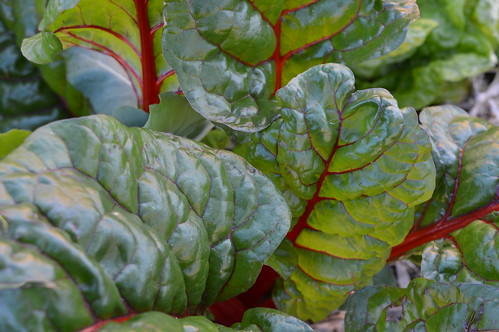
And sculptural lettuces by the handful
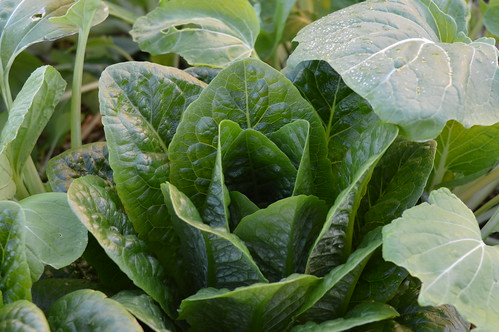

As you can tell, I feel very poetic about this bed of greens!
Monetarily, considering how pricey greens are and how apt to go manky in the bottom of the fridge, I’d estimate this bed neatly paid for all the seeds and seedlings I bought. I haven’t made a dent in the cost of the beds themselves, but you know, I don’t expect to. Honestly this bed gave me a thing I can’t buy – fresh, delicious, healthy greens available any time of the day or night. And I relished it.


I’m interested in both sewing and gardening, so my preference is to read about both in one place. I’ve been very interested to read about your wicking beds as that’s something I’ve been vaguely considering for my garden.
I’m glad they’re not just interesting to me! Obviously I’ve only had the beds less than a year but I;d recommend them. They take a fair bit of effort to set up but it just makes gardening so much easier and less full on, for me.
I like both! I find sewing and gardening very complementary. We have wicking beds too, did I tell you? They’re not my project though, they’re Mr T’s. We probably put them in at a similar time to you. One is veges and the other is fruit trees (tamarillo, feijoa, lemon) and herbs.
No, I didn’t know that! Did you have to do a deeper one for the trees? I suppose those plants all grow well in pots anyway.
I take it back, the tree one isn’t wicking, just set up so it looks exactly the same. Trees don’t know, they are doing pretty well considering the huge heat we’ve had recently!
LIES!!! No, I mean, those dumb trees don’t know anything. Just tell them it’s a wicking bed and they’ll never know the difference.